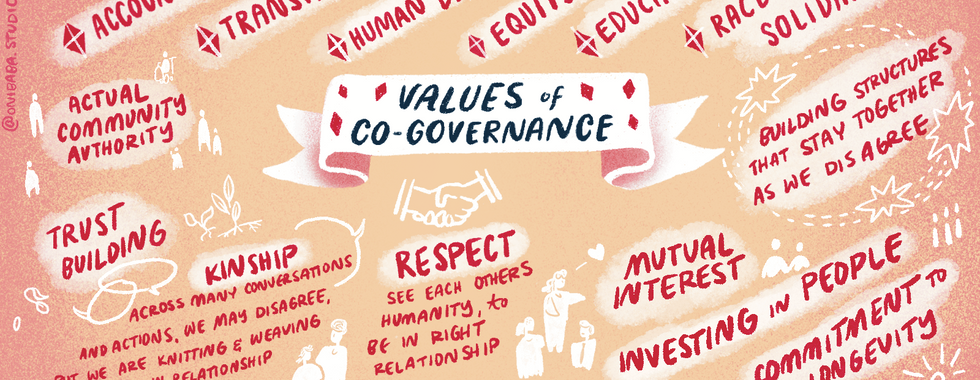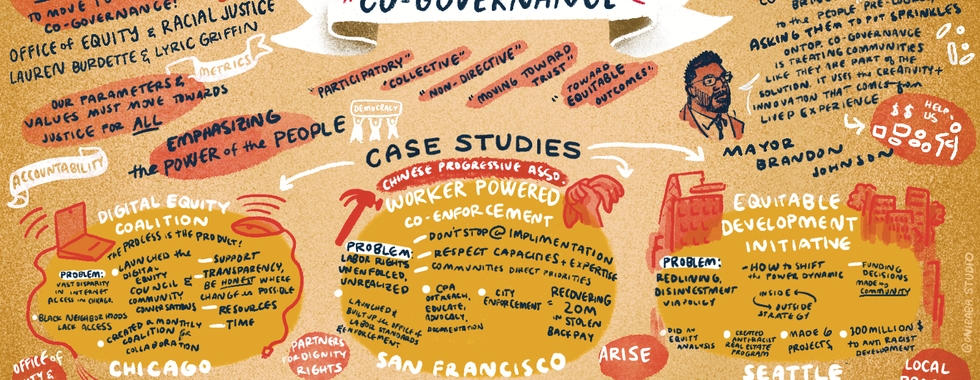Defining Co-Governance for the City of Chicago
- Admin
- Nov 6, 2023
- 4 min read
Updated: Nov 7, 2023
Exploring Co-Governance, a convening for Chicagoans in government and community to reimagine leadership, on September 25, 2023.
Defining Co-Governance
The event kicked off with opening remarks by Niketa Brar, Executive Director and Co-founder of CUE, who welcomed 100 city government and community leaders to the conversation.

“We all know the difference between leadership for policy change and leadership for government transformation…it’s about civic love.” —Niketa Brar

Above: Niketa Brar gives the opening remarks at Exploring Co-Governance in Chicago & Beyond in Washington Hall at Harold Washington College.
Co-Governance is NOT bringing ideas to the people pre-baked asking them to put sprinkles on top. Co-Governance is treating communities like they are a part of the solution. It uses the creativity and innovation that comes from lived experience. — Mayor Brandon Johnson, Chicago
Right: Mayor Brandon Johnson addresses the participants, many of whom served on his transition team. Photo by City of Chicago/ Patrick Pyszka.
Team members from the Office of Equity & Racial Justice led an exercise on defining co-governance, inviting participants to discuss how these definitions met or fell short of their expectations. One participant recommended adding the idea of “kinship” to the official definition of co-governance. We know we’re going to encounter disagreements, “vehemently”, and kinship becomes the foundation to come back together and return to the issue at hand.

In the past, Chicago has barely been able to inform communities. We want to move towards true co-governance. —Lauren Burdette, Office of Equity & Racial Justice
Lyric Griffin (left), Project Manager, and Lauren Burdette (right), Deputy Chief Equity Officer, hold up the defining co-governance worksheet. Burdette serves on CUE’s Board of Directors. Photo by City of Chicago/ Patrick Pyszka.
Watch the highlights from Exploring Co-Governance, including special interviews with Niketa Brar (CUE), Candace Moore (OERJ), Renaldo Hudson (Illinois Prison Project), and Kesi Foster (Partners for Dignity and Rights).
Case Studies Exploring Co-Governance in Action
Thanks to our partners with OERJ, Local Progress, and Partners for Dignity & Rights, participants got to hear from leaders in three different major cities and learn from their approaches to co-governance at the local level.
DIGITAL EQUITY COALITION
Chicago, Office of Equity & Racial justice

Chicago Housing Authority has families throughout the city. This is a extra resource. In one phone call I was able to help connect a senior to everything she needed to cross the digital divide. — Patricia Steward, Chicago Housing Authority
Right: Patricia Steward, Chicago Housing Authority, and Devon Braunstein, Digital Equity, answer questions about the Digital Equity Council. Photo by CUE staff.
Problem: Broadband policy is complex, and decisions being made in Springfield perpetuate a vast disparity in internet access in Chicago, primarily its South and Southwest sides.
Action: OERJ launched the Digital Equity Council and community conversations. A partnership with Circle Roots Collaborative made sure the people most impacted by the digital divide were at the center of the conversations. They created a monthly coalition for collaboration and provided community leaders with a stipend and all participants with a gift card.
Outcome: OERJ held 17 community conversations over 6 months to understand the biggest barriers to digital equity, brainstormed solutions, and assigned small groups to focus on individual solutions. These insights were published in their Digital Equity Plan.
WORKER POWERED CO-ENFORCEMENT
San Francisco, Chinese Progressive Association (CPA) and Chicago, Arise

CPA's work with the City and County of San Francisco, along with a similar effort in Seattle, helped inspire Chicago to help launch the Chicago Office of Labor Standards and develop a strong collaborative relationship between the worker's center and the agency.
Left to Right: Adam Kader, Public Policy Director at Arise Chicago Worker Center, Kesi Foster, Co-Executive Director of Partners for Dignity and Rights, listen to Ben Palmquist, New Social Contract Initiative for Partners for Dignity and Rights, discuss the history of CPA. Photo by City of Chicago/ Patrick Pyszka.
Problem: Labor rights were unenforced and unrealized, leading to stolen wages and dangerous working conditions. There was a lack of political will to change these conditions.
Action: Since the 1930’s, CPA has been organizing the low wage workforce, launching outreach strategies to educate workers, advocate for rights, electoral organizing and document responses from public agencies. City enforcement to recover $20 mil in stolen back pay and $1.7 mil in fines.
Outcome: CPA’s efforts built worker and organizational power (including shifting norms), strengthened an institution (OLSE), strengthened workers’ rights ecosystem through partnerships and coalitions, recovered millions ($20 mil) in back wages and created a national model: “co-enforcement” – to monitor and enforce labor rights.
EQUITABLE DEVELOPMENT INITIATIVE
Seattle, Office of Planning & Community Development
This case study was brought to you by Local Progress. LP is a network of elected leaders who build power with underrepresented communities and fight to reshape what is possible in our localities all across the country.

To me, there is a difference between neighborhood and community planning. Long term relationships were built through community planning, which creates opportunities for capacity building and long range neighborhood planning. — Patrice Thomas, Equitable Development Initiative
Right: Patrice Thomas, Project Manager for OPCD's Equitable Development Initiative, listens to opening remarks at Exploring Co-Governance. Photo by City of Chicago/ Patrick Pyszka.
Problem: Historical disinvestment via policy that redlined Black, Brown, and immigrant communities in Seattle.
Action: OPCD hosted 6 community-led demonstrations across the city’s redline. They launched an Equity Analysis and used those findings to create a Equitable Development Framework which became the foundation for the Equitable Development Initiative, providing $100M in anti-racist development grants to community applicants.
Outcome: The Equitable Development Initiative now has a permanent advisory board to ensure funding decisions are made by the community. OPCD ensures grantees not only receive their check but all the administrative information needed to manage their project. This inside/outside strategy has allowed the city to shift the power dynamic in local real estate and development practices.
Principles & Values OF CO-GOVERNANCE
Above: Participants share their core principles and values of co-governance in small groups and with the entire room. Photos by City of Chicago/ Patrick Pyszka and CUE staff.
Over the course of the afternoon, we heard that Proactive Relationship Building means not leaving anyone behind. The People are involved at every level. There is no financial barrier to being part of the process. Together we move at the speed of trust and invest beyond Implementation. Community cohesion is the foundation for all co-design initiatives.
Now it's your turn to define co-governance. We've compiled the principles and values of co-governance discussed at the convening for a public vote. Share what you think are the core principles and values of co-governance for the city of Chicago.
















Comments